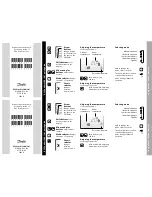
12
•
Chapter 2 Getting Started
DMC-1000
Step B.
Connect the amplifier enable signal.
Before making any connections from the amplifier to the controller,
you need to verify that the ground level of the amplifier is either
floating or at the same potential as earth.
WARNING: When the amplifier ground is not isolated from the power line or when it has a different
potential than that of the computer ground, serious damage may result to the computer controller
and amplifier.
If you are not sure about the potential of the ground levels, connect the
two ground signals (amplifier ground and earth) by a 10 K
Ω
resistor
and measure the voltage across the resistor. Only if the voltage is zero,
connect the two ground signals directly.
The amplifier enable signal is used by the controller to disable the
motor. It will disable the motor when the watchdog timer activates, the
motor-off command, MO, is given, or the position error exceeds the
error limit with the "Off-On-Error" function enabled (see the command
OE for further information).
The standard configuration of the AEN signal is TTL active high. In
other words, the AEN signal will be high when the controller expects
the amplifier to be enabled. The polarity and the amplitude can be
changed if you are using the ICM-1100 interface board. To change the
polarity from active high (5 volts = enable, zero volts = disable) to
active low (zero volts = enable, 5 volts = disable), replace the 7407 IC
with a 7406. Note that many amplifiers designate the enable input as
‘inhibit’.
To change the voltage level of the AEN signal, note the state of the
resistor pack on the ICM-1100. When Pin 1 is on the 5V mark, the
output voltage is 0-5V. To change to 12 volts, pull the resistor pack
and rotate it so that Pin 1 is on the 12 volt side. If you remove the
resistor pack, the output signal is an open collector, allowing the user
to connect an external supply with voltages up to 24V.
On the ICM-1100, the amplifier enable signal is labeled AENX for the
X axis. Connect this signal to the amplifier (figure 2.3) and issue the
command, MO, to disable the motor amplifiers - often this is indicated
by an LED on the amplifier.
Step C.
Connect the encoders
For stepper motor operation, an encoder is optional.
For servo motor operation, if you have a preferred definition of the
forward and reverse directions, make sure that the encoder wiring is
consistent with that definition.
The DMC-1000 accepts single-ended or differential encoder feedback
with or without an index pulse. If you are not using the AMP-11X0 or
the ICM-1100 you will need to consult the appendix for the encoder
pinouts for connection to the motion controller. The AMP-11X0 and
the ICM-1100 can accept encoder feedback from a 10-pin ribbon cable
or individual signal leads. For a 10-pin ribbon cable encoder, connect
the cable to the protected header connector labeled X ENCODER
(repeat for each axis necessary). For individual wires, simply match
the leads from the encoder you are using to the encoder feedback
inputs on the interconnect board. The signal leads are labeled XA+
Artisan Technology Group - Quality Instrumentation ... Guaranteed | (888) 88-SOURCE | www.artisantg.com
















































